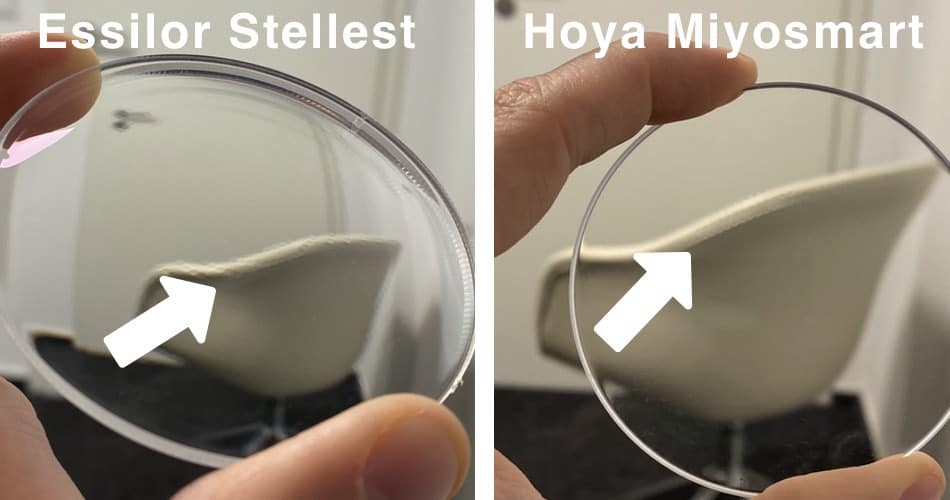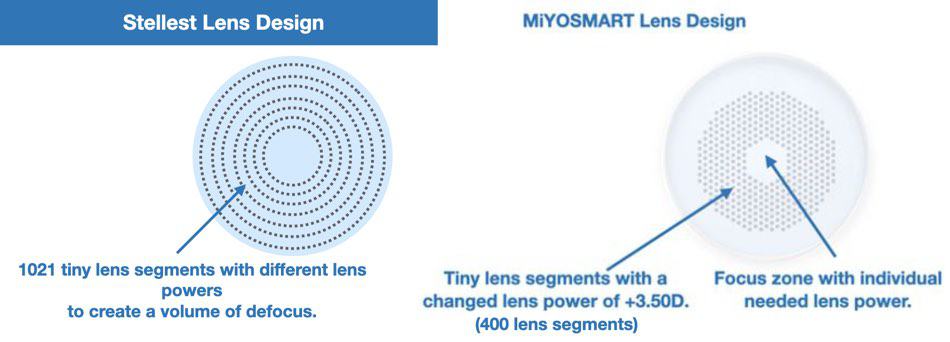This article is about the comparison of the Essilor Stellest Myopia control lenses and the Miyosmart lenses from Hoya. At first glance, the concepts of both manufacturers seem very similar. A large number of microlenses with less power are arranged in a circle around the center to bring the focus in the periphery closer to the retina.
Polycarbonate materials are also used by both manufacturers. Essilor calls it Airwear and Hoya uses polycarbonate under the index 1.59.
A layman will not be able to detect any difference between both lenses and conventional lenses. You really have to hold them at an angle against the light to be able to see the refraction on the microlenses in both cases.
If you then look at the lenses obliquely, you can observe the arrangement of the myopia control zones on the lenses very well. With Hoya Miyosmart, the area is concentrated in an area of 33mm around the center, while Essilor offers a larger area (the lenslets basically are distributed on the whole lens surface in the periphery) where the microlenses are found, the Miyosmart lens design offers a slightly denser arrangement of lenses around the center.
What counts is the experience. What is it like to see through the two lenses? How intensely does one experience the myopia control area when looking straight through the optical center. We have looked at all these aspects in this article. Read on to learn more.

Lens Designs Stelles vs Miyosmart
Hoya communicates the design of the Myosmart lenses very openly. It is known that the value of the micro lenses is 3.5 diopters. By the way, the value of the Miyosmart does not change for children with lower myopia or with higher myopia.
The Essilor Stellest lenses are different. Because there is some dynamic in the lens power of the microlenses. When the lens thickness varies on the surface around the eye, instead of an image plane, a space is created in which the light rays gather. Essilor describes this as a volume of myopic defocus (VoMD).
How effectively the lens designs work in the long run remains to be seen. Comparing the two lenses within studies is difficult, as the Miyosmart was tested for three years while the Essilor Stellest was launched after one year.
The Stellest is ahead with 67% slowing of myopia progression compared to 60% for the Miyosmart. But scientists will have to look at data over the next few years to see which lens design is more effective in general or only in certain children.
The central area of sharpest vision is 8mm for Stellest lenses and 9mm for Miyosmart. The difference is really marginal. We have tested both.
How Is It to Look Through the Miyosmart Compared to Stellest?
The front view is sharp as usual and only when you move your gaze to the sides do you notice that it becomes a bit blurrier. This is the case with the Miyosmart as well as the Stellest. The blur is only very slightly perceptible. It does not restrict the wearer’s spatial perception and you can move safely outdoors without any problems.

Study Design
The study period was significantly longer for the Hoya Miyosmart, at three years than for the Essilor Stellest, at one year until market launch. Both companies supported the studies (as in the case of Hoya in the three-year study) or participated in the studies (as Essilor did with its employees).
Experience With the Essilor Stellest Lenses and the Hoya Miyosmart Lenses
Both lenses are incredibly fast tolerated. The children put on the glasses with the Miyosmart lenses and tolerate the lenses easily. If your local optician offers Myopia control, he probably has both patterns in-house and can demonstrate them to you.
Hold the patterns in front of your eye yourself and give the pattern to your child. You will be surprised how little the altered margins affect vision. Conversely, if your child is beginning or already has nearsightedness, start wearing Miyosmart lenses or Stellest lenses. Both lens designs give you the opportunity to reduce the progression of myopia by more than half.
This ensures that your child will have developed less myopia by the time he or she is an adult. Thus, your child is freer and has a lower risk of suffering from certain eye diseases.
„High myopia maculopathy is the number one cause of irreversible blindness in Taiwan, Japan and China“
(Wu, Chang, et al., 2018)
Unfortunately, many children never get to experience one of these great lens designs. On the one hand, the option is raised far too rarely and on the other hand, there is far too often the desire to wait and use normal lenses or contact lenses for another year.
If there is a progression of myopia, especially if it is an increase of half a diopter per six months, then these two lens designs are the means of choice to slow down the progression.
Alternatively, you could use atropine drops or Ortho K lenses. With the Miyosmart and the Stellest, the experience of care around the correction of refractive error is a major aspect. At least every six months, a control measurement should be performed after the delivery of the glasses to see how the eye has changed and whether the child is still optimally corrected.
Often corrections are updated again too late out of fear that the value of myopia might have increased. But this is not an adequate approach to the correction of myopia.
The Prices for the Miyosmart and the Essilor Stellest
Prices for both lens designs are around $600 for a pair. In addition, the eyeglass frame is still to be added. Depending on the service and calculation of the optician, the price can vary down or up. The added value for your child is much greater with these new types of lenses than with conventional single vision lenses.
This does not mean that nearsightedness will not progress. In fact, in individual cases, it can still progress with both lenses. But on average, myopia progresses much less with the Stellest and Miyosmart compared to conventional lens designs.
